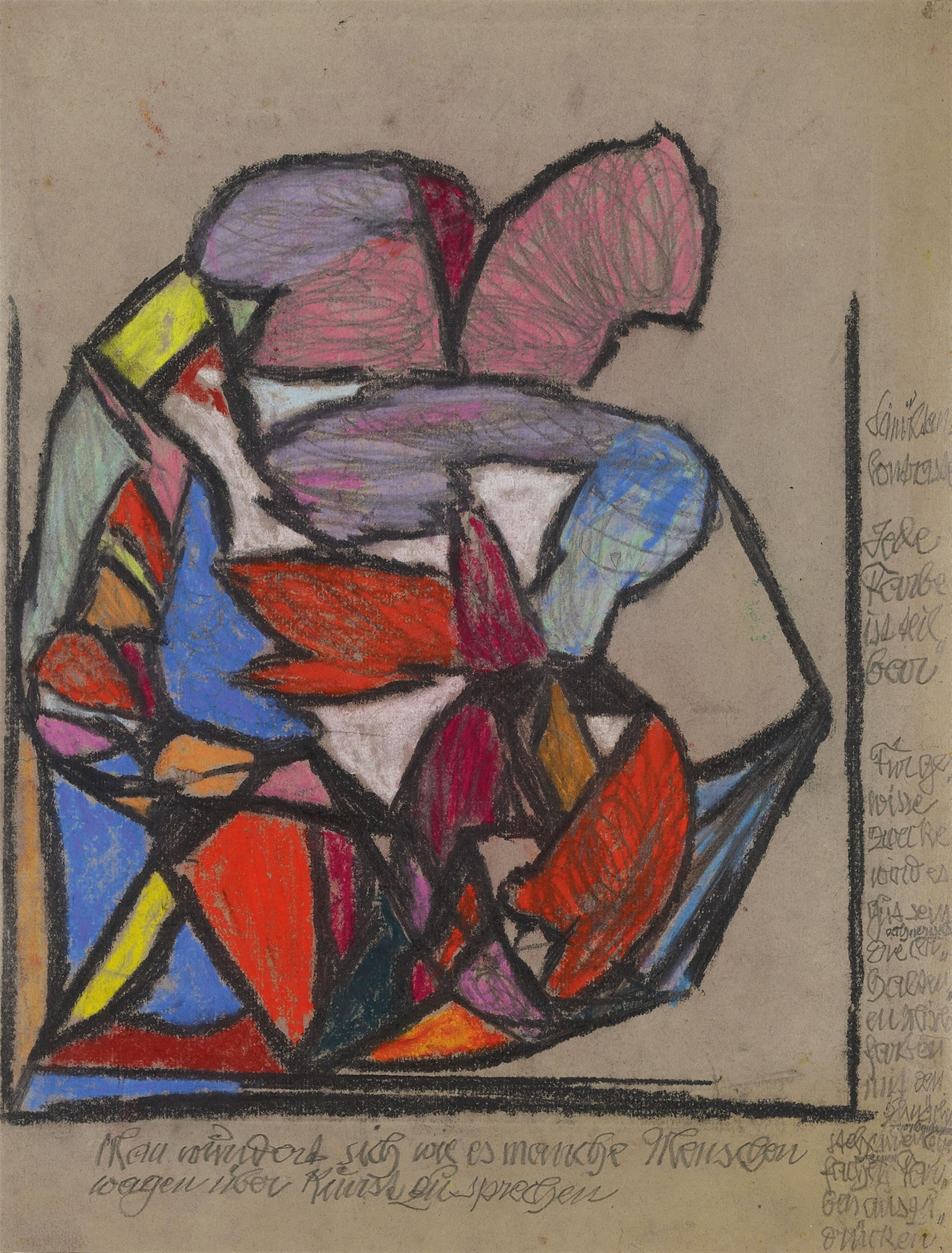Adolf Hoelzel
Abstrakte Komposition ("Man wundert sich...")
Circa 1925
Pastel crayon and graphite on grey, fibrous, ribbed drawing paper, handwritten text in pencil in the margin 46 x 35 cm Framed under glass. Unsigned.- Estate stamp "Nachlaß Prof. Adolf Hölzel" verso. - The sheet slightly irregularly cut. - Slightly browned throughout. Old tears in the margin and some localised paper defects within the depiction professionally restored.
Hölzel's marginal texts with the handwritten, barely legible additions are as follows: "It is amazing that some people/ dare to speak about art." resp. "Simultaneous=/ contrasts/ Every/ colour/ is divis/ible./ For cer/tain purposes/ it will/ be good/ to express/ the [calculated] obtained mixed colours/ with the/ initial [existing] sim/ple [pure] colours."
Adolf Hölzel's formative influence on the development of abstraction in Germany had few counterparts. In this context, not only his significance as an artist but also as a theorist and a teacher of artists like Willi Baumeister, Johannes Itten and Oskar Schlemmer can not be overestimated. In the spirit of the avant-garde he understood his artistic practice as a process crossing the boundaries between different areas of activity which ranged all the way from visual art, music and literature to scientific issues.
The linking of text and image already characterised Adolf Hölzel's work in his “abstract ornaments” from around 1900, and it found a much-noted form in his so-called “Schriftsockelbilder” from around 1915. In these works, Hölzel succeeds in organically linking textual and pictorial elements in a unique manner. In the subsequent course of his oeuvre he repeatedly created works based on this fundamental model. In the course of time they came to be characterised by formally less strictly linked, more fragmentarily assembled elements, whose interconnection became more and more associative. (Cf. Michael Lingner, Exerzitien - Ornamente - Konzepte, Zur Eigenart der Schrift(sockel)bilder im “Theoretischen Nachlass” von Adolf Hölzel, in: Kaleidoskop: Hölzel in der Avantgarde, exhib. cat. Kunstmuseum Stuttgart 2009, p. 134.) In the 1920s Hölzel's approach became even freer: with his graphite, ink or coloured pencil drawings on sheets of paper that had already been printed or written on, he created an experimental complex of works of extraordinary vitality within the space between figuration and abstraction.
The present work on paper is an outstanding example of Hölzel's works on the borderline of artistic practice and theory. The pastel composition is arranged with an extreme lightness and framed in black on three sides; it points both to Hölzel's famous designs of the 1920s and 1930s for stained-glass windows and to his boldly coloured pastel compositions of that period. This gestural work defined by a palpable spontaneity demonstrates Hölzel's modernity and innovative power. The text fragments at its left and lower edges can be understood within the context of Hölzel's extensively developed theories, which were the subject of intense attention at Stuttgart's academy of fine arts. It was through his students Schlemmer and Itten that Hölzel's pioneering theory of the pictorial elements and his complex theory of colour ultimately found their way into the instruction provided at the Bauhaus.
Certificate
We would like to thank Alexander Klee, Vienna, for scientific advice.
Provenance
Artist's estate; Private collection, South Germany

